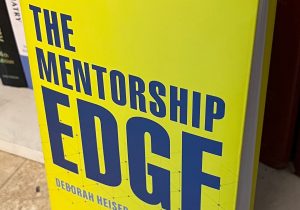Not that Kind of Committee: Tales of Faculty Committee Design
If you are like me, one of the best parts of completing graduate school was no longer having committee meetings every six months. Oh the glorious freedom of doing research without having to prepare for these meetings! Then I started working on my career development award and quickly realized my break from semi-annual committee meetings was rapidly coming to end. While the function of your thesis committee is to help guide your research, the function of your faculty mentoring committee is to guide you through tenure and promotion. As many have pointed out, you need mentors (yes, plural). As always these days, n=me, and this is how I structured my faculty mentoring committee.
 Who to exclude: Some departments have formal requirements as to who should be excluded from faculty mentoring committees. In the absence of these guidelines, here are the individuals that I excluded from my faculty mentoring committee.
Who to exclude: Some departments have formal requirements as to who should be excluded from faculty mentoring committees. In the absence of these guidelines, here are the individuals that I excluded from my faculty mentoring committee.
Junior faculty: While there is a lot of value from peer mentors, the point of your faculty mentoring committee is to guide you through the tenure and promotion process. Limit your committee to individuals who have successfully navigated the promotion and tenure process at your institution. In my case, I meet with fellow junior and recently promoted faculty over coffee for camaraderie and wisdom, but I only included full professors in my faculty mentoring committee.
Your Chair: Unless required to do so, do not include your Chair in your mentoring committee. Your mentoring committee guides you through all aspects of your faculty appointment, including concerns or conflicts with your Chair. Obviously, this is impossible if the Chair is on said committee. Also, as one of my mentors pointed out, you want your Chair to see all your achievements and not necessarily all of your failures. I had one additional reason to exclude my clinical Chair: he simply lacks the expertise in navigating promotion and tenure for a basic scientist, a fact he freely admits. Instead, my Chair and I meet monthly for updates and leave the faculty mentoring to fellow basic and translational scientists.
Who to include: These are the mentor-types I have included. Some mentors fit more than one category.
The booster: You will need someone who will cheer you on and boost your spirits. I was devastated at my lack of progress in the first six months. My booster pointed out I had a semi-functioning lab and a grant submitted and these were good things. I needed to hear that.
The institutional connector: You need someone to plug you into things you never knew you needed. My institutional connector plugged me into a small institutional committee with a small time commitment that satisfies some of my tenure’s service requirement and puts me in front of people I need to know.
The troubleshooter: Sometimes your science or trajectory needs a little help. This person always has a solution and will offer it readily. I would argue most of your mentoring committee should have troubleshooting inclinations. One of the things my troubleshooting mentors did was provide guidance in breaking down my massive planned manuscript into several smaller papers. For my upcoming meeting, I actually have two papers outlined.
The pessimist: It is good to know what the worst case scenario is and this person will tell you. In my case, the worst case scenario largely has to do with funding (or rather, its absence). Hearing how hard it is to secure funding drives me to work harder. The pessimist can also be the realist: one of my mentors told me to stop applying for very prestigious awards, since I was not competitive for them. While it was not particularly fun to hear, I did pass on a series of these applications, and it allowed me to focus on other things, like writing papers.
The field insider: Someone should know the relative ins and outs of your field. They can introduce you to the big names, identify good study sections for your research, and help grow your national reputation. I am lucky to have a couple of these on my committee, and I have grown my network considerably in the past year thanks to these people.
With your committee in place, it is now time to put together a mentoring committee document. Think of this is a faculty equivalent of the individual development plan (IDP). In my next post, I will cover what I put into mine. Stay tuned for more tales!
Did I miss an important point? Do you have questions or concerns about the post? Or perhaps an anecdote to contribute! Feel free to send some electrons my way in the comments, via Twitter @PipetteProtag, or through traditional electronic mail pipette.protagonist@gmail.com






0 Comments